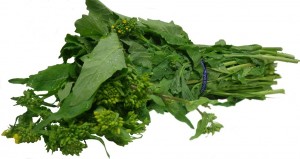Health Benefits of Nutrient-Packed Wild Mustard Greens

Geri Wohl, CNC www.bettereatingcoach.com
Most of us probably only think of mustard as a condiment, but actually the leaves, seeds and stems of the mustard plant are all edible. The seeds are used to spice Indian and other foods, to make the condiment mustard and to produce mustard oil. The stems can be cut finely and sautéed or added to salads or even juiced. As for the mustard leaves, these dark green leafy veggies are incredibly good for you.
Mustard greens are members of the cruciferous family that includes broccoli, cabbage, cauliflower, kale and Brussels sprouts. As such, they have similar health benefits as other cruciferous vegetables. Mustard is a cool weather crop, growing between November and March. It produces yellow flowers that go to seed once the weather begins to warm. Some growers use mustard as a mulch to prevent weeds from growing between their crops. As a cover crop, mustard is also used to infuse organic materials into the soil and to suppress soil-borne diseases.
So besides mustard’s advantages to our soil, what does it do for us? It is one of the most nutritious of the green leafy vegetables. Just like the other leafy greens, it is low in calories—just 26 calories for 100 grams of leaves. It is full of wonderful nutrients, namely vitamins A, C, K, E and folic acid. Mustard greens also are excellent sources of the minerals calcium, iron, magnesium, potassium, zinc, selenium and manganese. They also contain some protein and very little fat.
Mustard greens have been associated with preventing arthritis, osteoporosis, iron-deficiency anemia, asthmas and lung diseases. In fact, in olden days, mustard compresses were used to treat lung ailments including whooping cough, congestion and bronchitis. This may be due the fact that mustard greens contain plentiful quantities of vitamin A, carotenes, vitamin K and flavonoid antioxidants. The high level of vitamin A in mustard greens (350% RDA in 100 grams) supports the skin and other mucus membranes throughout the body as well as vision support. Keeping our lungs functioning well is especially important during the winter when upper respiratory bugs are in full force.
 Folic acid, found in mustard greens, is an important component to our cardiovascular health. Mustard greens contain about 47% of the RDA, more than spinach, kale or broccoli. Folic acid, being a key nutrient in heart health, helps prevent an increase of homocysteine, an inflammatory marker of cardiovascular risk.
Folic acid, found in mustard greens, is an important component to our cardiovascular health. Mustard greens contain about 47% of the RDA, more than spinach, kale or broccoli. Folic acid, being a key nutrient in heart health, helps prevent an increase of homocysteine, an inflammatory marker of cardiovascular risk.
In addition, these pungent greens are a great source of dietary fiber. Dietary fiber helps our digestive system and has been found to assist in controlling cholesterol. A lot has been written about having fiber in our diet. But why is it so important? When the body has too little fiber, the food going down the digestive tract can become stagnant and lead to constipation. However when the insoluble fiber in mustard greens is part of a healthy diet, the fiber attracts water into the digestive tract. As such, the waste is softened and allows for better elimination. The fiber further assists by removing toxins from the body, allowing the digestive tract to function as it was designed and reducing the risk of digestive diseases. In addition, dietary fiber helps to maintain a healthier pH of the gut. For more on the importance of pH in the body, see my article http://www.bettereatingcoach.com/121112-its-good-to-be-green.html.
As mentioned above, dietary fiber supports the cardiovascular system by reducing cholesterol. Not only do we obtain cholesterol from food, but our bodies also manufacture cholesterol. The liver makes bile in order to break down fats. Bile is made partly from cholesterol. The fiber in mustard greens as well as other leafy greens attaches to the bile acids and then escorts the bound cholesterol out of the body instead of being absorbed. The liver plays a critical role in the process of bile formation and detoxification. For more info about the liver’s role, see my article http://www.bettereatingcoach.com/101712–wine-and-wellness.html. Researchers have found that this bile-binding ability is enhanced when mustard greens are steamed rather than when eaten raw.
Rich in antioxidants, mustard greens help prevent free radical formation and thus may reduce the incidence of chronic diseases such as the cardiovascular disease and cancer. The antioxidants in mustard greens help to support the liver detoxification systems that are important in neutralizing toxins in our bodies. By removing toxins, we make it less likely for the cells and their DNA to be damaged and form into cancerous cells.
If you’ve never tried mustard greens, here are some healthy and simple recipes from Carmelo Sigona. For a salad using mizuna, see my recipe at http://www.bettereatingcoach.com/recipe-fall-2012.html. Enjoy one of the hidden gems in the leafy vegetable family!










